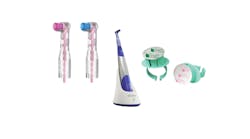I’m often approached by my former students who have been practicing for a few years, and they ask, “So, is this it? Is clinical hygiene, alone in an operatory, how I will spend the next 30-plus years of my career?” Well, no. This doesn’t have to be it. Many clinical hygienists love what they do and they’ll work in clinical with fervor for the next 30 years. But for others, it’s not their passion.
Also by Kimberly Augustus
The importance of mentorship programs
If you’re thinking about changing your career path, it’s best to create a career development plan. Creating a plan will help you visualize where you want to go (figure 1).
Steps to create a successful career plan
- Identify your current position. Identify where you are currently. Include a list of your strengths and skills and which of those can be transferred into a new role.
- Identify your desired position. This part can be tricky, but where do you see yourself in the next five to 10 years? Do you find yourself more on the business side of dentistry, perhaps as hygiene manager for a corporate practice? Maybe you love sales and want to represent a dental supply company. Other options are mobile dentistry and teaching. I spoke with a fellow hygienist who is the oral health educator in a children's hospital, and she spends her time in the oncology departments. Her role was created to reduce hospital-acquired infections via the oral cavity. It includes educating medical providers, patients, and families in high-risk settings. The opportunities to change areas in your career are endless; it’s just a matter of searching and connecting.
- Plan your goal. You have a vision and now it’s time to figure out how you’ll get there. Goal planning is a great time to seek out others who are in your desired role and find out what steps they took to get there. This will give you guidance in areas where you’re lacking, as well as help you network with others in the field. List your goals in an easy-to-find area so that you can easily refer to them.
- Formulate a plan. You’ve sought advice and written down your goals, so now it’s time to figure out how you will achieve them. You’ll want to list the skills and education you’ll need for the next step and establish a timeframe for achieving each goal. Keep in mind that some goals will be short-term and others long-term. Once your plan is complete, start implanting it! It may be worthwhile to seek out a career coach, mentor, or accountability partner to be your advocate along the way.
- Analyze your progress. You should analyze your progress monthly, quarterly, at the six-month mark, and at year end. Revisiting your plan will keep you accountable and on task. You may find some things you need to redirect if all is not going as planned. But don’t give up! You may also find that you’ve become interested in a completely different area than what you started in. In this case you can rework the development plan to include your new goal.
Don’t settle for a career that is not serving you well. This could lead to burnout and resentment. In the words of Steve Jobs, “The only way to do great work is to love what you do. If you haven't found it yet, keep looking. Don't settle. As with all matters of the heart, you'll know when you find it.”







